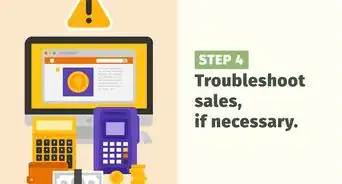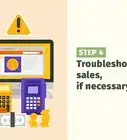wikiHow is a “wiki,” similar to Wikipedia, which means that many of our articles are co-written by multiple authors. To create this article, 14 people, some anonymous, worked to edit and improve it over time.
This article has been viewed 113,284 times.
Learn more...
The basis of good sales involves pairing a given product with a person who will be somehow better off owning it. It's the job of a salesman to match desires and needs with material solutions. Although a sale will be nearly impossible unless the customer thinks they'll somehow benefit from the purchase, a great salesman will elicit mutual understanding and seek an arrangement where everyone gets what they want. Making a sale involves more than the product itself. If you're looking to become an exceptional salesman, you need to sell a trustworthy image of yourself as well.
Things You Should Know
- Be punctual and dress professionally to put your best foot forward.
- Speak to customers in a warm, friendly way and avoid industry jargon.
- Find out your customer's needs and pitch the product as part of their ideal lifestyle.
Steps
Putting Your Best Foot Forward
-
1Dress to suit the circumstance. Many business gurus will state you need to look your best if you want to maximize your sales potential. While this is absolutely true, it doesn't necessarily mean dressing up in your finest suit. Rather, you should dress the way you think your customer would feel most comfortable and impressed with. Formal business wear is fairly standard in upper-level business spheres, but more casual settings might favour appropriately casual dress. As much as you'll want to impress the customer with your professionalism and adhere to the workplace's dress code, you also want to appear approachable and friendly.
- If you're making the sale employed under someone else, you'll also obviously need to consider how your boss will react to your wardrobe before taking the customer's whims into consideration.
- Semi-formal business wear fits the vast majority of business situations if you're unsure. As a rule, it is better to be too formal than too casual. Being too formal might make it harder to relate with the customer, but being too casual will make it harder for the customer to respect you. Respect is essential if you want to make a sale work.
-
2Be punctual. Punctuality is an incredibly simple (and easy) way to impress a customer and just about anyone else you'll be dealing with professionally. This doesn't just mean getting somewhere on time; it means being absolutely ready for whatever time you set to meet. This could involve coming fifteen minutes earlier than you are expected. By coming early, you'll have all of your things ready and have time to adjust for any unforeseen complications.
- An important side effect to punctuality is how much less stressed you'll feel. If you're prone to stress, getting to a sales meeting early will give you time to get your bearings and relax.
Advertisement -
3Attract the specific kind of customer you want. Part of a great sales routine is knowing exactly what you have to offer, and the kind of person that is going to want what you're selling.[1] If you have the ideal customer in mind, you can start to go ahead and imagine the sort of salesman they would be most inclined to buy from. Being able to predict your ideal customer's ideal salesman will gradually inform the way you present yourself.
- The more specific the type of customers you attract, the better (and easier) business will be for you.[2]
Earning Your Customer's Trust
-
1Know your customer.[3] Being aware of the circumstances and desires of whomever you're selling to is just as important (if not more so) than what you know about the product itself. What needs or desires does your customer have? And more specifically: How might those desires be sated by the product you have to offer? The key to positive, mutually beneficial interaction is being able to see things from the other person's point-of-view.
- Even if you don't know the customer on a personal basis, you can still assume a great deal about what they need. Most customers coming to one location are looking to have similar needs fulfilled. If you've dealt with enough customers in the past, you may have already seen some common patterns emerge.
- If it's another professional you're selling to, checking out his LinkedIn profile and looking into his industry will give you greater insight as to what he may be looking for.[4]
-
2Appraise your chances with the customer. Within the first few minutes of meeting with a prospective customer, you should be able to roughly determine how likely the sale is to go through. If you suspect the customer doesn't have a need for your product or doesn't have the funds to pay for it, it's best to speed the process along amicably. Although all customers should be treated with patience and respect regardless of your predicted chances, you don't want to waste time that might better be spent helping other people.[5]
-
3Actively engage with your customer.[6] Once you've met up with your prospective customer, you should engage with them as if they were a casual friend, rather than purely as a business associate. Given some of the bad stigma towards sales representatives, many people have the negative impression that salesmen are only out there to take their money. In order to instill a positive relationship with the customer, you must show interest in them as a human being.
- This can be as simple as asking them how they're doing today, or how their trip over to the meeting was.
- Actively engaging means doing without prepared sales pitches. If customers get the impression that a pitch has been memorized beforehand, they will have a hard time feeling engaged by it, even if the pitch itself is well-presented.
- For example, you might say something like this to appear warm to your customer: "It's great to have you here. Did you have a pleasant trip over?"
-
4Put the customer first.[7] Even if your ultimate goal is to sell a product, you can only maximize your chances of that if you put your customers needs before your own. People are quick to notice when someone sincerely cares about them, and even quicker to tell when they're getting the short end of the stick. The only way to ensure the customer will believe you're on their side is to actually be on their side.
- If you're having trouble figuring out how to manifest this idea in a real-life sales situation, try to picture yourself in the other person's shoes. What does the customer want? How might he be reacting to your tone, and what will it take for him to leave the meeting feeling happy and satisfied?
Selling Your Product
-
1Know your product. It should be taken as a granted that you cannot hope to sell something without having some knowledge of what it is and how it might benefit someone. Whether it's a used television or a hot stock, you should take time to analyze the product you're pitching. Try to look at it objectively as well as emotionally. Potential buyers are driven by emotions as much as logic, so it's important to consider subjectivity in your analysis.[8]
- A hot stock, for example, may carry a logical risk and reward, but it also represents a dream of possibly making a lot of money quickly.
- If you take a look at successful marketing campaigns, you'll find that products are rarely sold primarily due to superior technical specifications or anything logical. Consumers are more driven by egocentrism and what some might call a "coolness" factor.[9] So long as the product meets a basic standard of function, a large portion of a given consumer base will be open to purchasing it.
-
2Frame the product as part of the customer's ideal lifestyle. All people, customers or not, are ultimately striving for their ideal of a good life. While the particulars may vary significantly from person to person, most people want many of the same things: success, relative comfort, and the respect of their peers. It doesn't matter what the product itself is; for a product to be sold effectively, there has to be a part of the customer's life it will benefit or improve. Form a synthesis between what you know of the customer's needs and the benefits of the product. Build your sales pitch on whatever overlap there is.
- For example, someone selling a new refrigerator might highlight how it will benefit the customer's energy efficiency and the appliance's superior ease-of-use when compared to their current model.
-
3Close the deal. A sales process is never complete without the act of selling itself. Make the applicable transaction between buyer and seller, whether that's an exchange of cash or signing a lease. You should never been too confident before a deal is closed officially. On occasion, customers will get cold feet at the last minute and duck out, and acting like you've already won them over before that time may put undue pressure on them.
- Don't wait too long to close the deal.[10] It's natural to feel some trepidation when it comes time to finalize a sale. No salesman likes having his pitch rejected. All the same, if you leave a sale in progress for too long, you may lose momentum and have your business stolen by more aggressive competition.
-
4Remember to do a follow-up.[11] There are two reasons to get in touch with a customer following a sale. Even if you've already sealed the deal with them, contacting them later on to ask about their experience with the product creates a professional relationship beyond the sales pressure itself. Secondly, in getting feedback from a customer, you may receive helpful advice regarding your sales approach.
- Returning customers are where you are going to make the majority of your money in most business environments. Offering returning customers a special discount or offer is a great way of convincing them to come back.[12]
- While most customers won't fill out a customer response survey on their own time, many can be persuaded to do so if you offer a special perk, such as a discount for repeated service.[13] Done in this fashion, you're not only able to promote returning customers; you're also able to ensure a steady stream of feedback.
Warnings
- No matter how skilled of a salesman you are, there's never any guarantee you'll be able to seal a deal with a customer every time. The best you can do is maximize your chances. If you begin to notice a stretch of bad luck, however, it may be time to reevaluate your approach.⧼thumbs_response⧽
- While someone may jest that an exceptional salesman could "sell ice to Eskimos", the reality is that you cannot feasibly sell a product to someone with no need or desire for it.⧼thumbs_response⧽
References
- ↑ http://www.blackenterprise.com/small-business/5-tips-for-selling-anything-to-anybody/
- ↑ http://www.blackenterprise.com/small-business/5-tips-for-selling-anything-to-anybody/
- ↑ http://www.inc.com/steve-tobak/how-to-sell-anything-to-anybody.html
- ↑ http://www.inc.com/geoffrey-james/10-things-everyone-should-know-about-selling.html
- ↑ http://www.inc.com/geoffrey-james/10-things-everyone-should-know-about-selling.html
- ↑ http://www.inc.com/geoffrey-james/10-things-everyone-should-know-about-selling.html
- ↑ http://www.inc.com/steve-tobak/how-to-sell-anything-to-anybody.html
- ↑ http://www.copyblogger.com/psychological-selling/
- ↑ http://www.copyblogger.com/psychological-selling/
- ↑ http://www.inc.com/geoffrey-james/10-things-everyone-should-know-about-selling.html
- ↑ http://www.blackenterprise.com/small-business/5-tips-for-selling-anything-to-anybody/
- ↑ http://www.blackenterprise.com/small-business/5-tips-for-selling-anything-to-anybody/
- ↑ http://www.blackenterprise.com/small-business/5-tips-for-selling-anything-to-anybody/
- ↑ http://www.inc.com/geoffrey-james/10-things-everyone-should-know-about-selling.html
About This Article
To sell anything to anybody, start by actively engaging your customer as if they were a casual friend and show interest in them as a human being. For example, appear warm to your customer by saying something like “It’s great to have you here. Did you have a pleasant trip over?” Make sure you avoid delivering memorized sales pitches, which can turn off the customer. Also, frame the product in a way that shows the customer that it will benefit and improve their life. For more advice, like how to earn your customer’s trust, keep reading!








































































